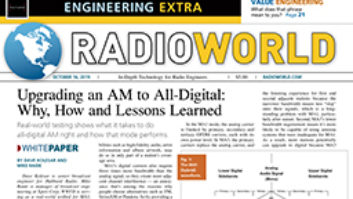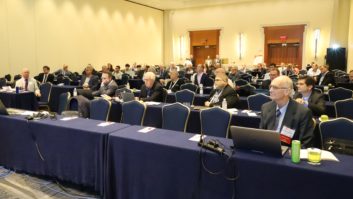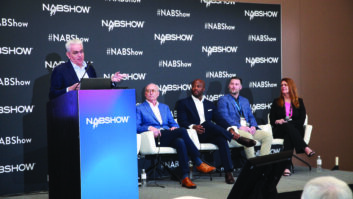Dave Kolesar is senior broadcast engineer for Hubbard Radio. Mike Raide is manager of broadcast engineering at Xperi Corp. WWFD is serving as a real-world testbed for MA3, which the authors say provides more coverage and less adjacent-channel interference than hybrid MA1.
For AM stations, today’s HD Radio technology hasn’t done much to level the playing field with FM, satellite and streaming services such as Spotify. One major reason is that the current system uses the MA1 waveform, which, although it provides HD Radio capabilities such as high-fidelity audio, artist information and album artwork, may do so in only part of a station’s coverage area.

MA1’s digital carriers also require three times more bandwidth than the analog signal, so they create more adjacent channel interference — an annoyance that’s among the reasons why people choose alternatives such as FM, SiriusXM or Pandora. So by providing a better listening experience for some stations, MA1 actually undermines others.
But HD Radio has another, far superior waveform that AM stations could use: MA3, which minimizes the interference problem and extends HD Radio’s capabilities to the vast majority of a station’s coverage area. The difference is MA3 is an all-digital signal, whereas MA1 is a hybrid of analog and digital.
In the MA1 mode, the analog carrier is flanked by primary, secondary and tertiary OFDM carriers, each with its own power level. In MA3, the primary carriers replace the analog carrier, and their power increases by 15 dB. MA3 also relocates the secondary carriers to the upper sideband and the tertiary carriers to the lower sideband, and both have their power increased to –30 dBc.
Thus the MA3 mode requires 20 kHz of bandwidth, while MA1 needs 30 kHz.

MA3’s spectral efficiency provides two major benefits. First, MA3 protects the listening experience for first and second adjacent stations because the narrower bandwidth means less “slop” onto their signals, which is a longstanding problem with MA1, particularly after sunset. Second, MA3’s lower bandwidth requirement means it’s more likely to be capable of using antenna systems that were inadequate for MA1. As a result, more stations potentially can upgrade to digital because MA3 enables them to avoid the expense of replacing their antenna system.
Over the past year, WWFD in Frederick, Md., has served as a testbed that vendors, broadcasters and the FCC can use to understand how upgrading a station to MA3 affects antenna systems, transmitters and engineering practices. Here are the lessons learned so far, and a preview of the drive-test results that will be covered in a follow-up article.
THE STRATEGY AND BUSINESS CASE FOR GOING ALL-DIGITAL
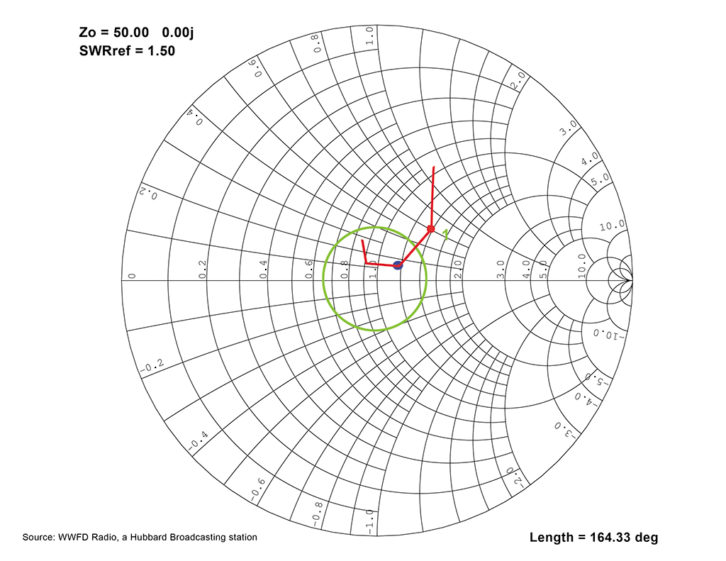
Owned by Hubbard Radio, WWFD runs an adult album alternative format on 820 kHz. It operates 4.3 kW non-directional during the day and switches to a 430 W two-tower array at night.
WWFD also has a 160 W translator, W232DG, on 94.3 MHz. Most WWFD listeners migrated to the translator after it signed on in July 2017, which made it feasible from a business perspective to replace the analog carrier with MA3 on an experimental basis.
If those tests were successful enough to continue using MA3, the translator could be used to educate listeners about the availability and benefits of the all-digital AM outlet. One example is explaining that when the translator’s signal starts to fade, they can switch their vehicle’s HD Radio to 820 and keep enjoying crystal-clear music for another 30–50 miles.
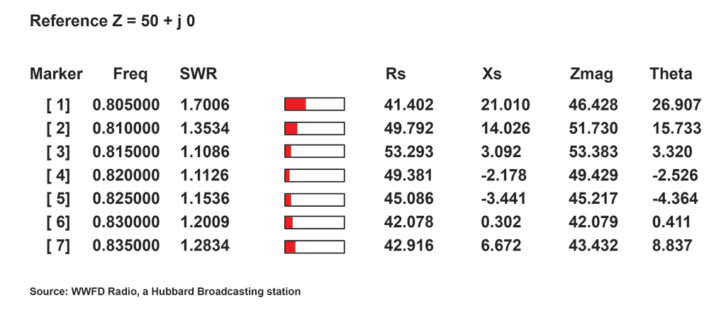
The FCC granted Hubbard a one-year STA to operate WWFD in MA3 mode, a switch that took place on July 16, 2018. Getting to that point took a lot of time, effort and collaboration with Kintronic Laboratories and Cavell, Mertz and Associates for the antenna system, and Broadcast Electronics, Nautel and GatesAir for the transmitters. Xperi Corp. lent its expertise to set up the digital transmitters, and to verify the operation of the antenna system.
GETTING A 58-YEAR-OLD ANTENNA SYSTEM DIGITAL READY

Early on, the MA3 mode would be used on 1670 kHz via a diplex into the existing 820 kHz antenna system. The 820 antenna system had undergone several modifications over the decades, including tower changes as part of a frequency change in 1987, and had not been characterized since it was last modified in 1991.
The first step was to measure every coil and capacitor, verify schematics and correct mistakes. Kintronic Labs helped with this process by analyzing the results and recommending changes. For example, they determined that the antenna system’s day and night performance was inadequate for all-digital transmission — no surprise, considering that WWFD has always been entirely analog and never used the MA1 mode. To support digital operations, a rule of thumb says that the SWR should be 1.4:1 ±15 kHz from the center frequency. WWFD’s was 1.8:1 at 10 kHz for the day mode, and 2.1:1 at 10 kHz for the night mode.
To bring things to the desired levels, Kintronic Labs redesigned the phasor and ATU networks. The goal was to enable optimal phase shifts to provide enough bandwidth to support all-digital transmission, while also keeping the number of new components to a minimum.
Several challenges stood in the way. For example, WWFD’s two towers are less than 90 degrees high, which restricts the bandwidth of the tuning units. The system also has filter and detuning networks both for the 1670 kHz operation and to protect another station whose 930 kHz facility is less than a mile away.
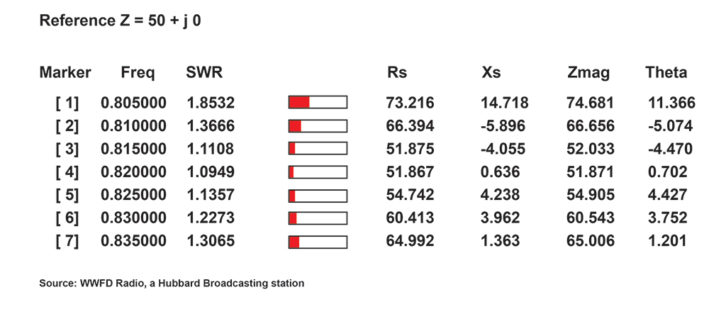
One set of changes involved the ATUs, where the L networks were converted into T networks so the phase shifts could be adjusted to optimize bandwidth. Inside the phasor, the T networks that adjust each tower’s phase shift were converted to series LC networks. This enabled fine-tuning controls for the larger shifts at the ATUs. Longstanding issues needed to be addressed as well. One example is the discovery of an unbonded, abandoned RPU line, which had created extra capacitance across one tower’s base insulator, adversely affecting the tower’s self-impedance.
The daytime network uses only the T network in tower 2, where the tuning process simply required adjusting for an impedance of 50 + j0 at the transmitter. With all of the modifications and repairs, the bandwidth turned out to be more than adequate, with a measured SWR of less than 1.35:1 at ±10 kHz.
The two-tower directional nighttime array was more complicated. Dummy loads were inserted at each ATU’s input, with an Array Solutions Power AIM 120 looking backward into each network from the antenna side. The matching networks were then set for the complex conjugate of the drive point impedance measured when the array had been in substantial adjustment.
With the networks reconnected, the phasor controls were used to put the array back into substantial adjustment. A bridge was inserted at the output of each phasor port, and the transmission lines were matched to 50 + j0 using the “cut and try” method.
Finally, the input network to the phasor (i.e., the “common point”) was adjusted to provide the transmitter with an impedance of 50 + j0. Now in tune, the night network was swept for bandwidth, and had an SWR of not more than 1.37:1 at ±10 kHz. The entire antenna system was now capable of passing the MA3 waveform.
FINDING THE RIGHT TRANSMITTER
For analog, WWFD uses a Harris Gates Five as the main transmitter, with a Nautel AMPFET Five for auxiliary service. Re-using the AMPFET Five for MA3 wasn’t an option because it can’t support digital, so a BE AM-6A was brought in as the new main transmitter. A Nautel AM IBOC exciter and BE ASi-10 were added to generate MA3 waveforms, and for testing and demonstrating interoperability between different manufacturers’ equipment.
Next, each transmitter’s audio input was connected to its exciter’s magnitude output, while each transmitter’s external oscillator input was connected to the phase output. The first round of tests used the Nautel exciter and AM-6A transmitter, with the balanced magnitude exciter output interfaced to the balanced (left) audio input of the transmitter through an H-Pad variable attenuator.
The tests followed the manufacturer’s instructions for implementing the MA1 mode. Once the transmitter was tuned properly for MA1 operation, the exciter was flipped to MA3 mode. The transmitter’s audio input was set to not exceed 95 percent negative modulation, while positive peaks were typically above 150 percent.
With a spectrum analyzer monitoring the transmitter’s RF output, the phase delay was adjusted for minimum spectral regrowth. Ideally this adjustment should be done with the secondary and tertiary carriers turned off (i.e., in MA3 core mode, with just the primary carriers being transmitted). That’s because some regrowth may be hidden underneath the secondary and tertiary carriers in the full MA3 mode.
Now optimized, the MA3 secondary carriers were turned back on. At ±25 kHz from the channel center, the regrowth was limited to –65 dBc with reference to the pilot channel. These results ensure compliance with the NRSC-2 spectral emissions mask.
DEVELOPING A NEW POWER MEASUREMENT PROCEDURE

The STA didn’t change WWFD’s licensed operating parameters for power output and directionality. But because the MA3 mode is an OFDM method of transmission, all-digital power can’t be measured using the traditional analog AM practices.
For example, MA3’s peak-to-average ratio is significantly higher than that of analog AM, so the transmitter’s power level meter may read inaccurately. Also, if the transmitter isn’t optimized for MA3 mode, the peak-to-average ratio may be reduced, and a different power level reading may result than if the transmitter been optimally adjusted.
Thus, a new procedure is necessary to verify that transmitters are operating at licensed power when in MA3 mode.
INITIAL DRIVE RESULTS DEMONSTRATE REAL-WORLD BENEFITS
Qualitative field strength measurements used the station’s existing Potomac Instruments FIM-21 meter, which was checked against an FIM-4100, which is specifically designed to handle the MA3 mode. The FIM-21 and FIM-41 meters indicate lower field strengths in MA3 than what a FIM-4100 reads because the latter has passband filters that encompass the entire waveform. As a result, measurements must be compared side-by-side, and a multiplication factor for each individual meter (due to variances in the IF filter sections for the FIM-21 and FIM-41 meters, or any superheterodyne meter) should be used when a qualitative check is desired, and a newer meter is unavailable.
Daytime drive tests used multiple vehicles’ factory OEM radios. Under ideal daytime conditions, the MA3 primary carriers can be decoded down to the 0.1 mV contour, as confirmed via reception reports and drive testing at or near Harrisburg, Pa., Breezewood, Pa. and Cambridge, Md. Critical hours propagation phenomena typically reduce reliable coverage to the 0.5 mV contour.
Nighttime MA3 reception generally follows the station’s nighttime interference free (NIF) contour: Wherever an analog carrier-to-noise ratio of 20 dB is achieved, the MA3 carrier will generally be received. Early evening reception goes well beyond the NIF. As co-channel skywave interference increases during the evening, coverage is reduced to the NIF. In the station’s 2.0 mV contour, in-vehicle reception was reliable, without zero dropouts in either the Frederick urban core or underneath bridges. Reliable urban performance is particularly important for competing with satellite, which often has dropouts even in cities with terrestrial repeaters.
The MA3 waveform is adversely affected by the deep nighttime null that WWFD uses to protect WBAP in Dallas. Drive testing shows that reception is lost on this axis before the predicted contour, due to the directional antenna system suppressing the center of the channel more than the sidebands. This is likely to be a common condition in arrays with high degrees of carrier suppression and disappears once off the null axis.
TO REVITALIZE, DON’T COMPROMISE
The work thus far by WWFD, Xperi and its other collaborators shows that MA3 has a viable, highly promising role in enabling the AM revitalization sought by both the industry and the FCC. This promise is reflected in NPRM petitions to allow MA3. One example is Bryan Broadcasting’s March 2019 petition, which subsequently received numerous positive comments in support. This growing interest and support among station owners, equipment vendors and the rest of the industry highlights why WWFD’s testbed is so important.
In particular, the drive tests demonstrate that MA3 can provide not only high-fidelity audio, but also album artwork, artist information and other data, throughout a station’s coverage area. All of these features will help AM stations compete with FM, satellite and streaming in both vehicles and homes.
Just as important, the drive tests show that MA3 avoids all of MA1’s biggest drawbacks, starting with excessive bandwidth requirements that result in adjacent-channel interference. Another is MA1’s annoying hiss due to how its digital carriers often bleed into the analog signal in receivers with wide IF bandwidth. Finally, unlike MA3, MA1’s digital carriers are 30 dB lower in amplitude than the analog carrier, which limits digital signal robustness and reception range.
Day and night drive testing currently is underway. Next time we will explore the lessons learned from those drive tests, and discuss further optimization of the antenna system as well as power measurement options.
Read Part 2 of this article here.
Comment on this or any story. Email [email protected].

